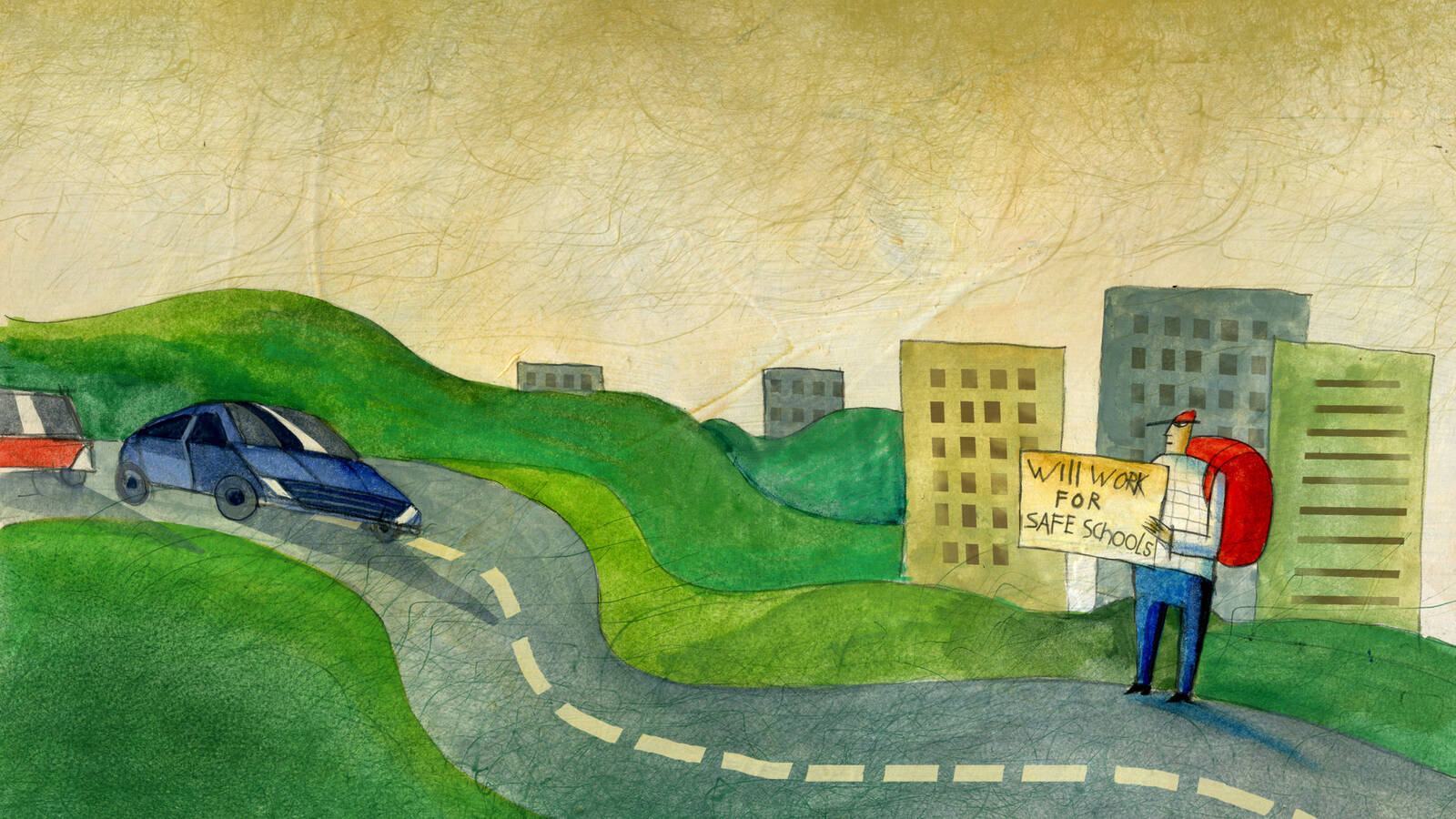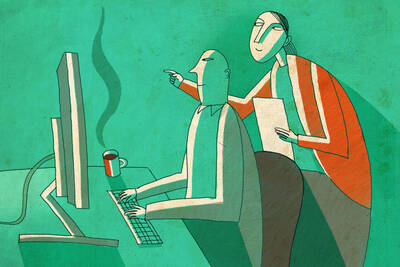Economics Social Impact Policy Mar 6, 2017
School Shootings Rise and Fall with the Unemployment Rate
Researchers set out to quantify gun violence at U.S. schools and made a surprising discovery.

Yevgenia Nayberg
When Adam Pah saw a headline claiming there had been more than 40 school shootings in the United States in early 2015, he was suspicious. The number seemed shockingly high, and the article did not provide a source for it.
Hoping to fact-check the dubious headline, Pah, a clinical assistant professor of management and organizations at Kellogg, searched online for gun-violence statistics. But what he found was a mess of vague and contradictory numbers. The existing data was limited, and definitions of “school shooting” seemed to differ from source to source. For example, does a shooting that occurs on the way to school count as a “school shooting”?
“I suddenly realized that no one knew if there were more, or less, or the same number of violent events involving guns at schools as the previous year,” Pah says. “It just kind of baffled me.”
That realization would lead Pah and coauthors to construct the most comprehensive database of U.S. school shootings to date. This allowed the researchers to reach a striking conclusion.
In a study recently published in Nature Human Behaviour, they show that the prevalence of school shootings is closely correlated with economic distress, meaning that shootings rise and fall along with economic indicators like unemployment and foreclosure rates. And the relationship stands up to statistical rigor. “No matter what level of the country you’re looking at or what metric of economic health, the relationship is always the same,” Pah says.
Depressing Data and Disney Songs
Pah and his coauthors—Luis Amaral, codirector of the Northwestern Institute on Complex Systems, Northwestern sociology professor John Hagan, Northwestern graduate students Kat Albrecht and Adam Hockenberry, and Northwestern undergraduates Andrew Jennings and Aditya Jain—started by creating their database. They did that by tracking down six existing lists of shootings compiled by media outlets, advocacy groups, and other academics.
“They feel that what they were promised their entire life is now kind of ripped away from them.”
“We took effectively every data source that’s ever been used and put them all together,” Pah says. “And from there we had our starting list.”
After some discussion, the authors agreed on three criteria that would determine which of the 535 events on the starting list should truly be considered school shootings: the incident must involve a gun being discharged, must involve students or school staff in some way, and must take place on the premises of a school.
“Which seems really basic but is kind of a change,” Pah says. “A lot of these reports would look at [incidents] near school or on the way to school.”
Then the hard work began. The researchers broke into three groups and independently researched all 535 events of school gun violence to determine which met their strict definition. “We’d start with, effectively, a date and a location,” Pah recalls. “And then we’d have to find a news article that corresponded with it. We’d have to read it, make sure the event actually happened, and what it was.”
“I think we’ve all spent 40 to 80 hours doing nothing but reading about gun violence at schools, which is pretty depressing,” he says.
One undergraduate on the project found a way to keep his spirits up while researching, Pah says: “He would listen to Disney songs while he did it.”
After weeks of painstaking research, the team regrouped and compared their lists, eventually coming to a consensus on 381 school-shooting events that took place between 1990 and 2013.
A Pattern of School Shootings Emerges
With the data in hand, the researchers’ first priority was to answer some basic questions—namely, how has the prevalence of shootings changed from year to year?
Pah anticipated that shootings would have increased significantly in the late 1990s. “I’m of the age where Columbine was this giant deal,” Pah says. “But that period didn’t have that many events of gun violence.”
Rather, the researchers were surprised to find that the two major periods of elevated violence were 1992–1994 and 2007–2013. “That’s when we thought, ‘OK, there’s something going on here,’” he says.
The team was especially puzzled by the surge in shootings since 2007. Guns had not become easier to obtain at that point, meaning that gun availability was not behind the increase. Nor was the increase explained by changing school sizes.
Rather, it seemed that some external factor was to blame. Pah and his colleagues began to wonder: Could shootings be linked to the state of the economy?
When they charted national unemployment levels alongside school shooting counts, there was a striking parallel—shootings and unemployment seemed to rise and fall in sync. Statistical tests confirmed the link. “What we found was that it was extremely significantly related,” Pah says.
But they wanted to make sure that they had found a genuine connection between economic conditions and school shooting rates, not just a fluke. So they tried the tests again, substituting consumer confidence and foreclosure rates for unemployment. Regardless of the economic indicator, the correlation remained strong.
Then they broke the continental U.S. into eight regions, and tested the unemployment correlation for each one. Then they did the same thing for six individual cities.
In every case, they found the same strong relationship between economic distress and school shootings.
“Which is rare,” Pah says. “Typically things aren’t that robust. But this persists.”
School Gun Violence and a Struggling Economy
Pah’s team had good reason to think there may be a connection between economic conditions and shootings. Previous studies had established that people affected by unemployment and economic uncertainty suffer from lower self-esteem and self-control. This can manifest in higher rates of drug and alcohol abuse. Perhaps it could lead to violence as well.
Why would this violence take place at schools, specifically? Pah and coauthors point out that school is traditionally the final step in a person’s path to the job market—but when fewer jobs are available, the link between education and steady employment begins to dissolve.
“If that last link is severed, it can have extremely negative outcomes for students,” Pah says. “They feel that what they were promised their entire life is now kind of ripped away from them.” As a result, those feelings of low self-esteem may then be directed toward a student’s last place of learning.
Evidence from the dataset supports the theory. In the 1990s, when it was easier to find a good job with less education, more shooting incidents took place in K-12 school buildings, Pah says. But in the 21st century, as a college degree has become more critical in the job market, more shootings have migrated to college and university campuses.
“It’s shifting with our society, as we change where we place the importance in the educational pipeline,” Pah says.
Moving (and Stopping) the Needle
Responding to the study, other scholars have argued that the shooters are themselves often students, and therefore may not be as aware of job scarcity as Pah and coauthors claim. The researchers found that 55% of shooters were current students.
“I understand that viewpoint,” Pah says, “but I think it dramatically undercuts how much students think about what’s coming next.” He argues that students not only begin thinking about their own prospects early on, but can perceive the state of the job market through friends and family as well.
“You don’t have to be working to know that it’s gone belly-up,” he says.
While the odds of any one individual being involved in a shooting are extremely low, Pah still believes it is crucial to understand why these incidents arise. “As a society, even though it is rare, it has an outsized impact on how safe we feel,” he says.
In future research, Pah hopes to explore how ethnicity and race interact with local unemployment to influence school shootings, and whether media coverage plays a role. The work is challenging, since real-world experiments can never be conducted. “So we’re left doing analysis as robustly as we can to ascertain what’s going on and how much we can possibly impact,” he says.
Pah acknowledges that no single finding or policy change will prevent every shooting—but he is hopeful that more research could lend insights as to how to keep shootings from edging upward.
“I’m looking at what we can do to stop the needle from moving,” he says. “We have to do a lot more work to figure out where we can use our resources as a society to help stem this problem.”



